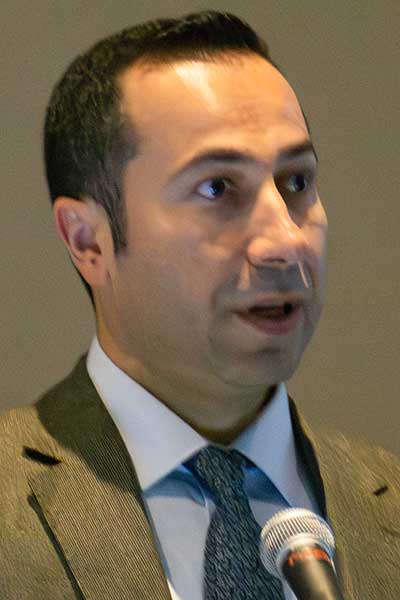Once-weekly semaglutide, compared to automated insulin delivery (AID) alone, improved the composite outcome of time in range (TIR) ≥70% and promoted a 5% reduction in body weight among adults living with type 1 diabetes and obesity currently on AID therapy.

These findings from the ADJUST-T1D phase 2 study were presented for the first time at the 85th Scientific Sessions during the Monday, June 23, symposium, ADJUnct Semaglutide Treatment in Type 1 Diabetes (ADJUST-T1D) Trial Outcomes.
“We know that type 1 diabetes is not just insulin deficiency, it is a complex metabolic disease and clearly insulin therapy alone is not enough for optimal glycemic control,” said Courtney Ackeifi, PhD, Scientist in the Improving Lives program at Breakthrough T1D.
Although non-insulin therapies for type 1 diabetes exist, this population has largely been left behind in the current renaissance of metabolic therapy development, Dr. Ackeifi added.
The benefits of glucagon-like peptide-1 receptor agonist (GLP-1 RA) therapy, such as with semaglutide, have been established in individuals with type 2 diabetes, with and without concomitant overweight or obesity. Previously, the benefits of semaglutide had been evaluated in individuals with type 1 diabetes only in small or retrospective studies, although the majority (62%) of adults with type 1 diabetes in the United States are living with overweight or obesity.

“GLP-1 RAs may have the potential to be used as an adjunctive therapy in type 1 diabetes to improve glycemic control, decrease weight, insulin dose, and cardiorenal risk,” said Halis Kaan Akturk, MD, Associate Professor of Medicine and Pediatrics at the Barbara Davis Center for Diabetes, University of Colorado.
ADJUST-T1D, an investigator-initiated double-blind randomized phase 2 study, assessed the efficacy of once-weekly semaglutide as add-on therapy in individuals aged 18–65 years who had been living with type 1 diabetes for more than a year, had inadequate glycemic management (A1C 7%–10%) despite AID therapy for more than three months, and a body mass index (BMI) ≥30 kg/m2.
The study had a composite primary outcome of meeting all three of the following elements at the end of the trial—time in range >70%, time below range <4%, and weight loss of ≥5%—explained Janet K. Snell-Bergeon, PhD, MPH, Professor of Pediatrics and Epidemiology and Director of Clinical Epidemiology at the Barbara Davis Center, University of Colorado Anschutz Medical Campus.

Of the 72 patients enrolled in ADJUST-T1D, half each were randomized to receive either 1 mg of semaglutide, the available dose on the market at that time, or placebo, for 26 weeks.
“Thirty-six percent of individuals in the semaglutide group achieved the primary outcome, compared to 0% in the placebo group,” said Viral N. Shah, MD, Professor of Medicine in the Division of Endocrinology & Metabolism and Director of Diabetes Clinical Research at the Center for Diabetes and Metabolic Diseases at Indiana University School of Medicine.
In the semaglutide arm, participants had a mean age of 41.4 years, and 61% were female. Among the 36 participants randomized to receive placebo, the mean age was 38.9 years and 56% were female. Participants were allowed to choose any available AID system for use but had to use that system consistently throughout the study period.
Dr. Shah highlighted the high adherence rate, with more than 90% of patients completing the study.
Key secondary outcomes included change from the randomization visit in A1C, continuous glucose monitoring (CGM) metrics, BMI, and insulin requirements, as measured by changes in insulin dose, total daily insulin dose, daily basal and bolus doses, with and without adjustment based on body weight.

Dr. Shah noted the “remarkable” improvement in A1C levels at the end of the study, which changed from a baseline mean of 7.8% to 7.1% in the semaglutide group and from a baseline mean of 7.7% to 7.4% in the placebo group. Similar improvements in glucose levels were seen with semaglutide.
Discussing key secondary outcomes based on CGM metrics, Dr. Shah reported semaglutide improved the time in tight range (TITR) by 8.8% and time in normal glycemia (TING) by 6.9%, compared to placebo, with concomitant decrease in the proportion of patients who had time above range, both at level 1 (>180 mg/dL) or level 2 (>250 mg/dL).
Dr. Shah also pointed out the persistent weight loss over 26 weeks had not yet reached a plateau, suggesting that extension of the treatment period to nine months or one year may further improve weight loss.
While the glycemic improvements were evident even at lower doses of semaglutide during the initial dose escalation period, the impact on weight was seen after final semaglutide dose had been reached.
Overall, there was a 30% reduction in insulin dose between the semaglutide-treated participants and those who received placebo.
The most common adverse events were gastrointestinal in both the semaglutide (52.8%) and placebo (25%) arms. The discontinuation rate in the semaglutide group due to gastrointestinal adverse events was 5.5%, consistent with rates reported in other studies in participants living with obesity.
Dr. Shah advocated for regulatory/registrational trials of semaglutide in type 1 diabetes.
Dr. Ackeifi framed ADJUST-T1D as an important first step in the use of semaglutide in type 1 diabetes and a big step in meeting the needs of people with type 1 diabetes. While AID systems have been the standard of care in type 1 diabetes, only 30% of adults with the disease in the United States currently achieve the optimal glycemia target of an A1C <7%, Dr. Akturk noted.
The primary analysis of the study was published simultaneously in the New England Journal of Medicine Evidence.
On-demand access to recorded presentations from this session will be available to registered participants of the 85th Scientific Sessions through August 25.

Watch the Scientific Sessions On-Demand after the Meeting
Extend your learning on the latest advances in diabetes research, prevention, and care after the 85th Scientific Sessions conclude. From June 25–August 25, registered participants will have on-demand access to presentations recorded in Chicago via the meeting website.

